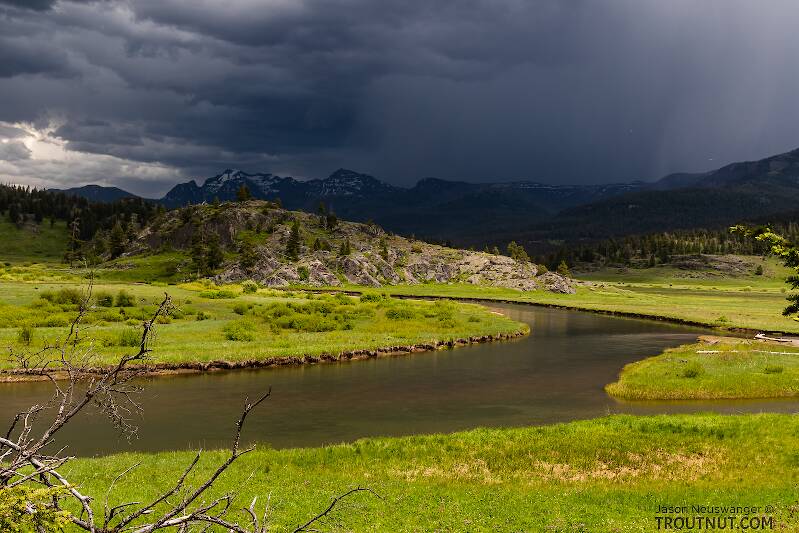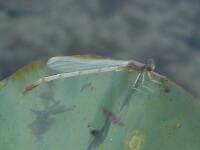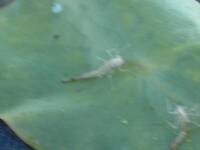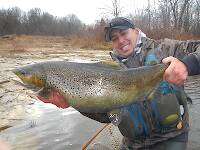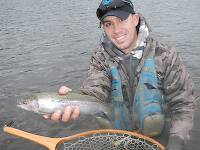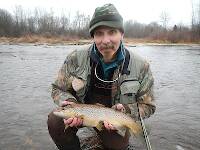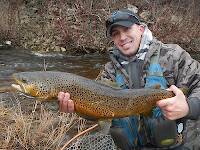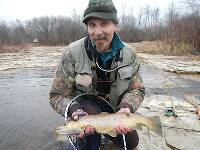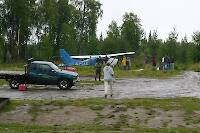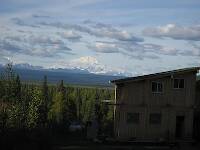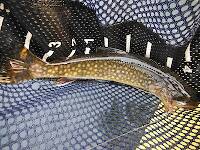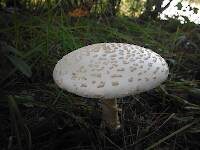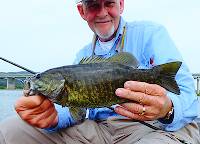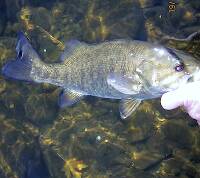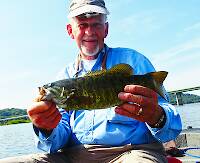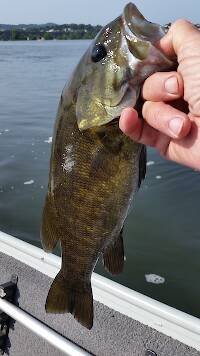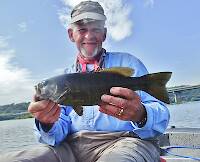
Salmonflies
Pteronarcys californica
The giant Salmonflies of the Western mountains are legendary for their proclivity to elicit consistent dry-fly action and ferocious strikes.
Featured on the forum

This species was fairly abundant in a February sample of the upper Yakima.

Troutnut is a project started in 2003 by salmonid ecologist Jason "Troutnut" Neuswanger to help anglers and
fly tyers unabashedly embrace the entomological side of the sport. Learn more about Troutnut or
support the project for an enhanced experience here.
Oldredbarn has attached this picture. The message is below.
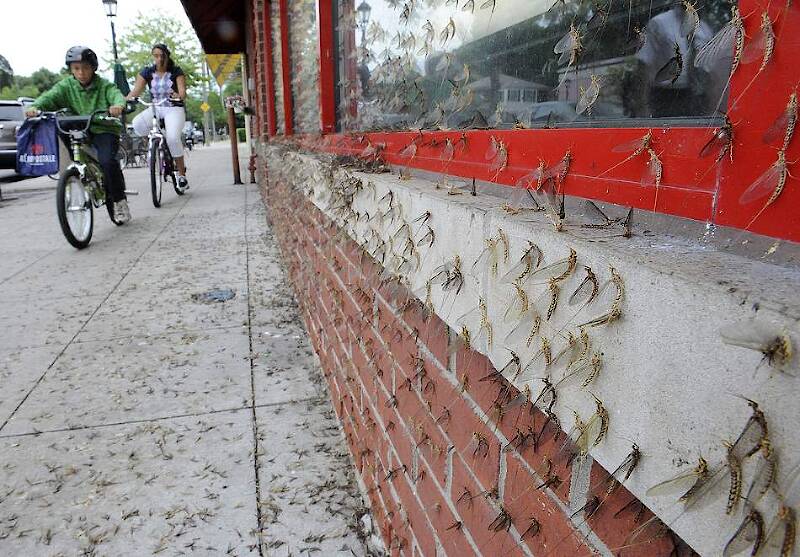
Oldredbarn on Jun 18, 2010June 18th, 2010, 3:21 am EDT
I'm having guests this weekend from Germany and in between I'm stuck behind a desk...I'm going crazy here!
Spence
Spence
"Even when my best efforts fail it's a satisfying challenge, and that, after all, is the essence of fly fishing." -Chauncy Lively
"Envy not the man who lives beside the river, but the man the river flows through." Joseph T Heywood
"Envy not the man who lives beside the river, but the man the river flows through." Joseph T Heywood
JOHNW on Jun 18, 2010June 18th, 2010, 3:35 am EDT
Simply friggin' incredible!
I've seen cahils like that along the Susky and the river coated with whiteflies but never anything with bugs of that size.
JW
I've seen cahils like that along the Susky and the river coated with whiteflies but never anything with bugs of that size.
JW
"old habits are hard to kill once you have gray in your beard" -Old Red Barn
Wiflyfisher on Jun 19, 2010June 19th, 2010, 2:27 am EDT
Great photo! Awesome hatch! Spence, did you take the photo with your new digital camera?
John S.
https://WiFlyFisher.com
https://WiFlyFisher.com
Jmd123 on Jun 19, 2010June 19th, 2010, 1:40 pm EDT
WHERE IS THIS?????
I'm dying here too - these things were starting to hatch a couple of weeks ago while I was up at the U of MI Bio Station, then also in Tawas Bay. Then the damned weather turned and I came down with some sort of vile stomach/intestinal virus or something and got stuck in a hotel room for almost a week trying to hold food down...
However, I do have to report one CRAZY night on the Maple River the first night of that trip. Even though there were three other cars parked at my favorite spot (in fact, where I LEARNED how to fly fish for trout on the Hex 25 years ago!), I saw no one once I hit the water. Then, with no flies in sight, the fish went ABSOLOUTELY INSANE for a SOLID HALF-HOUR before stopping cold as if someone hit a switch. I don't know if there was an emergence happening right underneath me - and they could have been either Hex or Light Cahills which hatch in numbers at the same time. Whatever it was, I had on a #10 or 12 White Wulff and the fish were hammering it, so much so that I noticed it was coming unravelled at the end of the night! First a brown about 5" long, then a brookie the size of my middle finger, then another little brownie just barely bigger than the brookie...I though, OK, at least little trout are better than none, or worse still, CHUBS. Well, then the next fish was a 12" brown, then an 11" BROOKIE (personal record!!!) that was just breathtakingly beautiful, and finally a 13" brown that jumped THREE FEET clear of the water FOUR TIMES in the first 5 seconds of the fight!! "This has GOT to be a rainbow!!!" Nope, brown trout all the way - must have been on CRACK or something!
Then everything stopped cold. Another half-hour of casting brought no more rises and the river fell completely quiet. The wind suddenly picked up, clouds blew in, and a little rain fell. Hmmmmmmm - something to do with the barometer, perhaps??? Two other guys I talked to shortly thereafter saw no flies and little feeding activity, so it would appear I just happened to find myself at the right place at the right time - !!!!
I've seen nights like that during the Hex and also during the Light Cahills when they were going good, but I SWEAR there were NO flies of any kind on that water and the fish just lost their minds! A few months ago I had a similar situation with bass on my local lake here in Troy - a half-hour feeding frenzy is the only way I can describe it, and it ended just as suddenly as it started, after having 8 bass on and five brought to net (all 11-14" largemouth), all on an original silver Killer Bass Fly. And then it was over, no more hits, as a storm front was predicted to be coming through. ?????
Anyway, I want to be where those flies are. And another thing - there's got to be a way to fish those hatches on lakes when the nymphs are emerging, as YOU KNOW the perch, walleye, whitefish, etc. must be just chowing down on them as they fight their way up through the water column! Anybody ever try this??
Jonathon
I'm dying here too - these things were starting to hatch a couple of weeks ago while I was up at the U of MI Bio Station, then also in Tawas Bay. Then the damned weather turned and I came down with some sort of vile stomach/intestinal virus or something and got stuck in a hotel room for almost a week trying to hold food down...
However, I do have to report one CRAZY night on the Maple River the first night of that trip. Even though there were three other cars parked at my favorite spot (in fact, where I LEARNED how to fly fish for trout on the Hex 25 years ago!), I saw no one once I hit the water. Then, with no flies in sight, the fish went ABSOLOUTELY INSANE for a SOLID HALF-HOUR before stopping cold as if someone hit a switch. I don't know if there was an emergence happening right underneath me - and they could have been either Hex or Light Cahills which hatch in numbers at the same time. Whatever it was, I had on a #10 or 12 White Wulff and the fish were hammering it, so much so that I noticed it was coming unravelled at the end of the night! First a brown about 5" long, then a brookie the size of my middle finger, then another little brownie just barely bigger than the brookie...I though, OK, at least little trout are better than none, or worse still, CHUBS. Well, then the next fish was a 12" brown, then an 11" BROOKIE (personal record!!!) that was just breathtakingly beautiful, and finally a 13" brown that jumped THREE FEET clear of the water FOUR TIMES in the first 5 seconds of the fight!! "This has GOT to be a rainbow!!!" Nope, brown trout all the way - must have been on CRACK or something!
Then everything stopped cold. Another half-hour of casting brought no more rises and the river fell completely quiet. The wind suddenly picked up, clouds blew in, and a little rain fell. Hmmmmmmm - something to do with the barometer, perhaps??? Two other guys I talked to shortly thereafter saw no flies and little feeding activity, so it would appear I just happened to find myself at the right place at the right time - !!!!
I've seen nights like that during the Hex and also during the Light Cahills when they were going good, but I SWEAR there were NO flies of any kind on that water and the fish just lost their minds! A few months ago I had a similar situation with bass on my local lake here in Troy - a half-hour feeding frenzy is the only way I can describe it, and it ended just as suddenly as it started, after having 8 bass on and five brought to net (all 11-14" largemouth), all on an original silver Killer Bass Fly. And then it was over, no more hits, as a storm front was predicted to be coming through. ?????
Anyway, I want to be where those flies are. And another thing - there's got to be a way to fish those hatches on lakes when the nymphs are emerging, as YOU KNOW the perch, walleye, whitefish, etc. must be just chowing down on them as they fight their way up through the water column! Anybody ever try this??
Jonathon
No matter how big the one you just caught is, there's always a bigger one out there somewhere...
TNEAL on Jun 20, 2010June 20th, 2010, 12:45 am EDT
Bestway I've found is to fish it with a Hex nymph. Fish it relatively deep and under motion, and hang on to your rod! Cruising fih will nail it hard.
GONZO on Jun 20, 2010June 20th, 2010, 9:38 am EDT
Jonathan,
I agree with Tim. Although I've sometimes had great fun fishing dun/emerger and spinner imitations when big burrowing mayflies (Brown Drakes as well as Hex) emerged from lakes, fishing the nymph was usually the more reliable and productive method.
Because of cooler water temps at the time of their emergence, the Brown Drakes often started earlier in the day and provided a better (or at least longer) opportunity to fish on the surface. However, because they never seemed to emerge in the same numbers as the Hex, rises were often rather spotty and spread out. At such times, the nymph fished more consistently. The Hex emergences, especially on hot days, were sometimes so brief and explosive that I only had time to target a few fish with dries before the water was covered by the evacuated husks of the nymphs and things shut down for the rest of the night.
The other complicaton is that targeting cruising risers in a big lake is a pretty challenging and often frustrating game. The trout and landlocked salmon that I pursued would typically feed on long circuits, rising about every 10-20 feet or so as they would cycle through the emergence areas. Casting directly in the neighborhood of a rise was usually pointless--most often, the fish would already be gone. (If a fish did rise twice in the same spot, it usually turned out to be a smallmouth or perch.) The cast had to be delivered to a spot that would anticipate the next rise of a fish in the hope that it wouldn't veer off its course or return to the starting point to begin a new circuit. When there was any breeze, the fish seemed to rise exclusively on the upwind leg of their circuits.
The only exceptions to this were when prevailing conditions would collect the flies into large scum lines, concentrating the rising fish. At such times, you could just cast a dry to the area of the scum line and wait for a fish to cruise by. This was a passive way of fishing, but waiting for the rise could often be nerve-wracking (especially when a fish would rise to a natural adjacent to your fly).
In contrast, fishing the nymph was often productive for a considerable amount of time prior to the big mayflies appearing on the surface and usually continued to fish well throughout the emergence. The nymph could either be fished with a cast-sink-retrieve method or by slow trolling with a twitching action. The fishing that I did usually required some kind of watercraft in order to access the prime areas of feeding/emergence. Everything from float tubes to bass boats were used, but I liked to fin around in an inflatable pontoon boat. Fin-powered slow trolling was a simple, straightforward technique; the real trick was knowing where to troll. Otherwise, you'd get a good workout but no trout or landlocks. On the other hand, there were usually plenty of smallmouth and big yellow perch to keep you occupied, so even this wasn't entirely fruitless.
I hope that gives you some ideas. BTW, were you fishing around a riffle on the night that you described on the Maple? If so, I might have an idea about what was happening.
I agree with Tim. Although I've sometimes had great fun fishing dun/emerger and spinner imitations when big burrowing mayflies (Brown Drakes as well as Hex) emerged from lakes, fishing the nymph was usually the more reliable and productive method.
Because of cooler water temps at the time of their emergence, the Brown Drakes often started earlier in the day and provided a better (or at least longer) opportunity to fish on the surface. However, because they never seemed to emerge in the same numbers as the Hex, rises were often rather spotty and spread out. At such times, the nymph fished more consistently. The Hex emergences, especially on hot days, were sometimes so brief and explosive that I only had time to target a few fish with dries before the water was covered by the evacuated husks of the nymphs and things shut down for the rest of the night.
The other complicaton is that targeting cruising risers in a big lake is a pretty challenging and often frustrating game. The trout and landlocked salmon that I pursued would typically feed on long circuits, rising about every 10-20 feet or so as they would cycle through the emergence areas. Casting directly in the neighborhood of a rise was usually pointless--most often, the fish would already be gone. (If a fish did rise twice in the same spot, it usually turned out to be a smallmouth or perch.) The cast had to be delivered to a spot that would anticipate the next rise of a fish in the hope that it wouldn't veer off its course or return to the starting point to begin a new circuit. When there was any breeze, the fish seemed to rise exclusively on the upwind leg of their circuits.
The only exceptions to this were when prevailing conditions would collect the flies into large scum lines, concentrating the rising fish. At such times, you could just cast a dry to the area of the scum line and wait for a fish to cruise by. This was a passive way of fishing, but waiting for the rise could often be nerve-wracking (especially when a fish would rise to a natural adjacent to your fly).
In contrast, fishing the nymph was often productive for a considerable amount of time prior to the big mayflies appearing on the surface and usually continued to fish well throughout the emergence. The nymph could either be fished with a cast-sink-retrieve method or by slow trolling with a twitching action. The fishing that I did usually required some kind of watercraft in order to access the prime areas of feeding/emergence. Everything from float tubes to bass boats were used, but I liked to fin around in an inflatable pontoon boat. Fin-powered slow trolling was a simple, straightforward technique; the real trick was knowing where to troll. Otherwise, you'd get a good workout but no trout or landlocks. On the other hand, there were usually plenty of smallmouth and big yellow perch to keep you occupied, so even this wasn't entirely fruitless.
I hope that gives you some ideas. BTW, were you fishing around a riffle on the night that you described on the Maple? If so, I might have an idea about what was happening.
Oldredbarn on Jun 20, 2010June 20th, 2010, 10:55 am EDT
John,
That photo wasn't mine. It was lifted from a local newspaper and this is near the upper eastside of Detriot suburbs...St Clair Shores or such. These are from the upper part of the Detroit river where Lake St Clair empies in to the river.
I sometimes can't figure out how these guys reproduce when they are so easily drawn off-course by artificial light. Up where this photo is from it gets so bad at times that the bugs collect on the street under the street lights and cars have slid on them.
If you think of this hatch as protein for fish, birds, dragonflies, bats etc it really is incredible. As Gonzo was hinting at...The fishing can be tough when the fish are gorging on these critters...They literally stuff themselves. I have seen fish that could only be described as flipped out...
It's one of those things that needs to be seen at least once in an anglers life. On the river when it's on everything somehow seems fenzied...You can hear them and feel them banging in to you as you stand in the river...If you turn on your lamp they crash at the light...It's weird to say the least.
When the spinner flights can show up on doppler radar you know this is a different event. There are stretches of the Au Sable where the boat traffic looks like an expressway during rush hour...Like I said...It needs to be seen with your own eyes!
Spence
That photo wasn't mine. It was lifted from a local newspaper and this is near the upper eastside of Detriot suburbs...St Clair Shores or such. These are from the upper part of the Detroit river where Lake St Clair empies in to the river.
I sometimes can't figure out how these guys reproduce when they are so easily drawn off-course by artificial light. Up where this photo is from it gets so bad at times that the bugs collect on the street under the street lights and cars have slid on them.
If you think of this hatch as protein for fish, birds, dragonflies, bats etc it really is incredible. As Gonzo was hinting at...The fishing can be tough when the fish are gorging on these critters...They literally stuff themselves. I have seen fish that could only be described as flipped out...
It's one of those things that needs to be seen at least once in an anglers life. On the river when it's on everything somehow seems fenzied...You can hear them and feel them banging in to you as you stand in the river...If you turn on your lamp they crash at the light...It's weird to say the least.
When the spinner flights can show up on doppler radar you know this is a different event. There are stretches of the Au Sable where the boat traffic looks like an expressway during rush hour...Like I said...It needs to be seen with your own eyes!
Spence
"Even when my best efforts fail it's a satisfying challenge, and that, after all, is the essence of fly fishing." -Chauncy Lively
"Envy not the man who lives beside the river, but the man the river flows through." Joseph T Heywood
"Envy not the man who lives beside the river, but the man the river flows through." Joseph T Heywood
Jmd123 on Jun 20, 2010June 20th, 2010, 5:32 pm EDT
Spence, I have seen many a Hex hatch, including the one I think I told you about occuring directly over the bluegill/pumpkinseed spawning bed in the little lake I lived on up near West Branch (what a night!). I once had the priveledge (most people wouldn't call it that but hey, I'm a fly fisherman AND an entomologist) of walking directly into a mating swarm of these creatures, whereupon they parted in front of me then closed back around me once I had entered the swarm. The air was literally buzzing - they may look delicate but when there's a few hundred of them around you they can actually make some noise! On another night, I got to watch them flying in front of a gibbous moon (between first quarter and full) and their gossomer wings lit up like they were made out of crystal. These were some of the early mystical experiences I had while fly fishing at night that turned me into a hard-core flyrod addict...
You know, you're probably right about Hex fishing on lakes, now that I think about it - the volume of water is so much larger that you would have to chase fish all over the place to get into a good feeding concentration, whereas on a stream, you KNOW right where they'll be feeding...STILL, the idea of catching walleye or whitefish on a flyrod...hmmmmmmmm...smallies and perch work REALLY WELL for me too on flies...
Jonathon
You know, you're probably right about Hex fishing on lakes, now that I think about it - the volume of water is so much larger that you would have to chase fish all over the place to get into a good feeding concentration, whereas on a stream, you KNOW right where they'll be feeding...STILL, the idea of catching walleye or whitefish on a flyrod...hmmmmmmmm...smallies and perch work REALLY WELL for me too on flies...
Jonathon
No matter how big the one you just caught is, there's always a bigger one out there somewhere...
Wiflyfisher on Jun 21, 2010June 21st, 2010, 12:01 am EDT
I have fished smallies on our lake. The Hex hatch and the fish were pretty concentrated in the soft, mucky bottom areas. The hatch seemed to be in water 10-12 feet deep or less. The smallies were all over in the shallower water gulping them in and I had a blast.
It made me wonder for these burrowing nymphs how deep can they live? Also, do they need certain amount of oxygen (I am sure they must) and what about some sunlight too? As you get deeper the sunlight can't penetrate and the oxygen levels obviously are reduced.
It made me wonder for these burrowing nymphs how deep can they live? Also, do they need certain amount of oxygen (I am sure they must) and what about some sunlight too? As you get deeper the sunlight can't penetrate and the oxygen levels obviously are reduced.
John S.
https://WiFlyFisher.com
https://WiFlyFisher.com
Oldredbarn on Jun 21, 2010June 21st, 2010, 4:13 am EDT
Guys,
Go to www.gateslodge.com and once you are there toggle down and along the right there is a link to Josh's "Full Fishing Report"...He has a nice article there that gives a little of the feel & mystery of fishing the Hex in Michigan.
Spence
Go to www.gateslodge.com and once you are there toggle down and along the right there is a link to Josh's "Full Fishing Report"...He has a nice article there that gives a little of the feel & mystery of fishing the Hex in Michigan.
Spence
"Even when my best efforts fail it's a satisfying challenge, and that, after all, is the essence of fly fishing." -Chauncy Lively
"Envy not the man who lives beside the river, but the man the river flows through." Joseph T Heywood
"Envy not the man who lives beside the river, but the man the river flows through." Joseph T Heywood
Jmd123 on Jun 21, 2010June 21st, 2010, 9:14 am EDT
John, that sounds like avery nice situation you have there with those smallies. I'm not sure how deep they go - the Hex nymph is a borrower in silt banks and I believe they are somewhat of filter feeders - "collectors" in the proper aquatic entomology terminology. I would be curious to find out how deep they go too - I might have to do a little research in this area...
As I mentioned, I once found myself in the middle of a major Hex hatch right over a major bedding area for spawning bluegills and pumpkinseeds, and they didn't hesitate to rise up to the surface and start slurping them down! All I had for anything remotely resembling a Hex dry was a size 10 Female Adams, which was apparently good enough as I proceeded to pull in fish left and right...
Jonathon
As I mentioned, I once found myself in the middle of a major Hex hatch right over a major bedding area for spawning bluegills and pumpkinseeds, and they didn't hesitate to rise up to the surface and start slurping them down! All I had for anything remotely resembling a Hex dry was a size 10 Female Adams, which was apparently good enough as I proceeded to pull in fish left and right...
Jonathon
No matter how big the one you just caught is, there's always a bigger one out there somewhere...
Oldredbarn on Jun 21, 2010June 21st, 2010, 10:30 am EDT
Jon,
I'm going to remember to look that up for you. I have a memory of Justin Leonard discussing it in his Michigan Mayfly book...I think it's rather deep...All things considered.
I would think that if this is indeed the case the fish get pretty use to seeing these mouthfuls swiming to the surface...If you had a good version of the nymph, as Tim Neal said, it might be the ticket in the lake situation.
As you no doubt know "wigglers" are very popular here in Michigan as an ice fishing bait and perch love them...In my humble opinion the imitations I've seen in fly bins for sale need to go on diets! Their abdomens are too fat. I have seen some creative things done with after-shaft feathers and ostrich herl to imitate the gills on the nymph...This to me is a very important feature to replicate...If you have had "wiggles" in a bait bucket and watched them swim you would agree.
The fat versions are ok for smallies and perch, but I'm still biased when it comes to the discriminating tastes of a wild trout...Mr. Neal is no doubt laughing as he reads this because it's probably not true and he's been known to toss large wet versions of Mr. Madsen's skunk. I know that this fantasy is probably something I made up and is now lodged between my temporal lobes only, but I still think of "trout" as the prince and princess' of the stream...I still believe there's something to my ability to fool them no matter what Jason's final studies will show...:)
I will admit that having seen Mr. & Mrs. trout around Hex time they have a tendency to forget their table manners and act like pigs. Insane pigs! If I glued a drinking straw of the appropriate length to a hook, in their feeding frenzy, they would probably hit it...
I have also seen them, late in the hatch, refuse my offerings in the dark to the point I thought I would go mad! There is nothing sadder than a fellow floating downstream in the dark, way too many beers involved, way past his bedtime, a grown man mind you, with a thousand biting bugs biting away at every bit of exposed flesh...And as my guide friend said to others the next day..."Spence just couldn't close the deal!" Ouch!
Spence
I'm going to remember to look that up for you. I have a memory of Justin Leonard discussing it in his Michigan Mayfly book...I think it's rather deep...All things considered.
I would think that if this is indeed the case the fish get pretty use to seeing these mouthfuls swiming to the surface...If you had a good version of the nymph, as Tim Neal said, it might be the ticket in the lake situation.
As you no doubt know "wigglers" are very popular here in Michigan as an ice fishing bait and perch love them...In my humble opinion the imitations I've seen in fly bins for sale need to go on diets! Their abdomens are too fat. I have seen some creative things done with after-shaft feathers and ostrich herl to imitate the gills on the nymph...This to me is a very important feature to replicate...If you have had "wiggles" in a bait bucket and watched them swim you would agree.
The fat versions are ok for smallies and perch, but I'm still biased when it comes to the discriminating tastes of a wild trout...Mr. Neal is no doubt laughing as he reads this because it's probably not true and he's been known to toss large wet versions of Mr. Madsen's skunk. I know that this fantasy is probably something I made up and is now lodged between my temporal lobes only, but I still think of "trout" as the prince and princess' of the stream...I still believe there's something to my ability to fool them no matter what Jason's final studies will show...:)
I will admit that having seen Mr. & Mrs. trout around Hex time they have a tendency to forget their table manners and act like pigs. Insane pigs! If I glued a drinking straw of the appropriate length to a hook, in their feeding frenzy, they would probably hit it...
I have also seen them, late in the hatch, refuse my offerings in the dark to the point I thought I would go mad! There is nothing sadder than a fellow floating downstream in the dark, way too many beers involved, way past his bedtime, a grown man mind you, with a thousand biting bugs biting away at every bit of exposed flesh...And as my guide friend said to others the next day..."Spence just couldn't close the deal!" Ouch!
Spence
"Even when my best efforts fail it's a satisfying challenge, and that, after all, is the essence of fly fishing." -Chauncy Lively
"Envy not the man who lives beside the river, but the man the river flows through." Joseph T Heywood
"Envy not the man who lives beside the river, but the man the river flows through." Joseph T Heywood
GONZO on Jun 21, 2010June 21st, 2010, 4:28 pm EDT
John, Jonathan, and Spence,
A number of life history studies discuss the food and habitat requirements of Hexagenia nymphs in lakes (Rawson, 1930; Eggleston, 1931; Neave, 1931; Krieger et al., 2007).
The depths given for collection of the nymphs in these studies ranged from somewhere less than 2 meters down to a maximum of about 14-18 meters. The upper limit appears to be determined by the availability of suitable substrate. (The wave-washed shallows of large lakes can be sandy or rocky and may not have a sufficient quantity of fine mud or marl to accommodate their burrows.) The lower limit seems to be determined mostly by the concentrations of dissolved oxygen. In deep lakes, that is influenced by thermal stratification.
In a 1947 paper, Justin Leonard reported on the stomach contents of rainbow trout that fed on Brown Drakes and Hex in Birch Lake, Michigan. The rainbows fed only on the nymphs of the Hex, probably due to warm surface temperatures at the time of the Hex emergence. However, the Hex nymphs appeared steadily in their stomach contents over a 26-week span. In contrast, the rainbows fed on the Brown Drakes (both nymphs and duns) only during the annual emergence. To quote Leonard:
It made me wonder for these burrowing nymphs how deep can they live? Also, do they need certain amount of oxygen (I am sure they must) and what about some sunlight too? As you get deeper the sunlight can't penetrate and the oxygen levels obviously are reduced.
A number of life history studies discuss the food and habitat requirements of Hexagenia nymphs in lakes (Rawson, 1930; Eggleston, 1931; Neave, 1931; Krieger et al., 2007).
The depths given for collection of the nymphs in these studies ranged from somewhere less than 2 meters down to a maximum of about 14-18 meters. The upper limit appears to be determined by the availability of suitable substrate. (The wave-washed shallows of large lakes can be sandy or rocky and may not have a sufficient quantity of fine mud or marl to accommodate their burrows.) The lower limit seems to be determined mostly by the concentrations of dissolved oxygen. In deep lakes, that is influenced by thermal stratification.
In a 1947 paper, Justin Leonard reported on the stomach contents of rainbow trout that fed on Brown Drakes and Hex in Birch Lake, Michigan. The rainbows fed only on the nymphs of the Hex, probably due to warm surface temperatures at the time of the Hex emergence. However, the Hex nymphs appeared steadily in their stomach contents over a 26-week span. In contrast, the rainbows fed on the Brown Drakes (both nymphs and duns) only during the annual emergence. To quote Leonard:
Stomachs of trout taken on May 23rd, when a mass emergence of simulans occurred, averaged 507 nymphs and 106 subimagoes per stomach, one 18-inch rainbow containing 789 nymphs and 232 subimagoes.
Gutcutter on Jun 21, 2010June 21st, 2010, 4:41 pm EDT
summer of 1998 in lake county, ohio, i caught an 8 pound walleye in 12 ft of water "trolling" a hex nymph with a 6wt and class V line out of my float tube. i was fishing lake erie for smallmouth during the "lakefly" hatch and hooked the toothed one instead. don't ever let anybody tell you that a walleye can't put up a good fight...
All men who fish may in turn be divided into two parts: those who fish for trout and those who don't. Trout fishermen are a race apart: they are a dedicated crew- indolent, improvident, and quietly mad.
-Robert Traver, Trout Madness
-Robert Traver, Trout Madness
Jmd123 on Jun 21, 2010June 21st, 2010, 5:42 pm EDT
Someone here recently sugested a tan Woolly Bugger for a Hex nymph imitation. I'll go one better if I have the chance (though it will all be over very soon) - I have some tan-dyed "grizzly marabou" that I could use for the tailing, and maybe either natural grizzly hackle (maybe somewhat undersized?) or ostrich herl for the palmering...hmmmmm...
GC, good job on that walleye! There's nothing out there that can't be caught on a fly rod if you don't try something different once in a while.
Gonzo, thanks for the info on Hex ecology. Sounds like they can go pretty deep - provided they have the silt to burrow in, sufficient dissolved oxygen, and some good food particles to collect. GEEZ, imagine having to kick your way up through 18 meters = almost 60 feet (!!) of water just to emerge at the surface when you're a juicy two-inch-long mayfly nymph that swims an inch or two per second through hordes of hungry fish of every species...No wonder they all emerge at once so that at least SOME of them can survive!
I for one am glad that I am higher on the food chain that that...
Jonathon
GC, good job on that walleye! There's nothing out there that can't be caught on a fly rod if you don't try something different once in a while.
Gonzo, thanks for the info on Hex ecology. Sounds like they can go pretty deep - provided they have the silt to burrow in, sufficient dissolved oxygen, and some good food particles to collect. GEEZ, imagine having to kick your way up through 18 meters = almost 60 feet (!!) of water just to emerge at the surface when you're a juicy two-inch-long mayfly nymph that swims an inch or two per second through hordes of hungry fish of every species...No wonder they all emerge at once so that at least SOME of them can survive!
I for one am glad that I am higher on the food chain that that...
Jonathon
No matter how big the one you just caught is, there's always a bigger one out there somewhere...
Wiflyfisher on Jun 22, 2010June 22nd, 2010, 1:13 am EDT
Lloyd, thanks for the Hex info! The stats are a reminder to how important a nymph pattern is during a hatch. Although, I prefer an emerger pattern.
Our lake goes to 105 feet deep and I know I didn't see any out there. For the amount of hungry predators (bluegills, bass, walleye, crappies, birds, bats, etc..) there has to be a huge numbers of hatching nymphs in a lake to have some make it to the spinner fall.
Ironically, I have seen the next morning globs of shucked cases along the shoreline but I have never seen globs of dead spinners on the water.
I have never seen E. simulans on our lake. Yet, it's one of my favorite hatches on the rivers near by.
Our lake goes to 105 feet deep and I know I didn't see any out there. For the amount of hungry predators (bluegills, bass, walleye, crappies, birds, bats, etc..) there has to be a huge numbers of hatching nymphs in a lake to have some make it to the spinner fall.
Ironically, I have seen the next morning globs of shucked cases along the shoreline but I have never seen globs of dead spinners on the water.
I have never seen E. simulans on our lake. Yet, it's one of my favorite hatches on the rivers near by.
John S.
https://WiFlyFisher.com
https://WiFlyFisher.com
Oldredbarn on Jun 22, 2010June 22nd, 2010, 7:41 am EDT
Tim Neal said
Geez, Spence. You knocked out the dang web server!! :-)
Bestway I've found is to fish it with a Hex nymph. Fish it relatively deep and under motion, and hang on to your rod! Cruising fish will nail it hard.
Justin Leonard said via GonzoStomachs of trout taken on May 23rd, when a mass emergence of simulans occurred, averaged 507 nymphs and 106 subimagoes per stomach, one 18-inch rainbow containing 789 nymphs and 232 subimagoes.
Tim it appears there's some science to your Hex nymph fishing. The fish appear to be eating only 20-30% of the time on or near the surface...Us dry fly guys appear to be limiting our action.
That last boy was doing some serious eating there! He must of looked like a football.
I have posted elsewhere the time I spotted a nice sized fish ramming it's snout in to a muck bank for nymphs...He was flipping out. He jumped out of the water for no reason and dove back down in the hole and was banging his head in to the muck. Silt and dirt were clouding up the stream there downstream from him...It was great to watch. Tim...This was right at Daisy Bend in the middle of a very bright day with nothing else going on...
A couple old-timers walked up with cane rods and I said to them, "Hey! Anyone have a Hex nymph?" I pointed down in to the water for them to see what was going on. Now I am known as a dry fly guy and it was funny their response to me...They didn't know me and kind of gave me a derisive look like, "Nymphs! We don't use no stinking nymphs!" They looked down in to the hole, shrugged their shoulders and off they went...Probably thinking I was scum for suggesting they sink to the "dark art" of nymphing...I think, as humans will do from time-to-time, that they totally ignored what they were watching as if it was an anomaly and therefore of no interest. Oh well...You can lead a horse to water...But you can't make him think.
Good stuff guys. Another interesting post from trout-nuts!
Spence"Even when my best efforts fail it's a satisfying challenge, and that, after all, is the essence of fly fishing." -Chauncy Lively
"Envy not the man who lives beside the river, but the man the river flows through." Joseph T Heywood
Oldredbarn on Jun 22, 2010June 22nd, 2010, 7:42 am EDT
How in the hell did I do that?!! I'm not sure...
Spence
Spence
"Even when my best efforts fail it's a satisfying challenge, and that, after all, is the essence of fly fishing." -Chauncy Lively
"Envy not the man who lives beside the river, but the man the river flows through." Joseph T Heywood
"Envy not the man who lives beside the river, but the man the river flows through." Joseph T Heywood
Wiflyfisher on Jun 23, 2010June 23rd, 2010, 10:30 am EDT
How in the hell did I do that?!! I'm not sure...
Spence
Geez, Spence. You knocked out the dang web server!! :-)
John S.
https://WiFlyFisher.com
https://WiFlyFisher.com
Jmd123 on Jun 23, 2010June 23rd, 2010, 2:15 pm EDT
Look out now guys, Spence is gettin' all fancy on us!!!
Jonathon
Jonathon
No matter how big the one you just caught is, there's always a bigger one out there somewhere...
Quick Reply
Related Discussions
Topic
Replies
Last Reply
1
Jul 11, 2008
by Taxon
by Taxon
2
Apr 25, 2016
by Afishinado
by Afishinado

